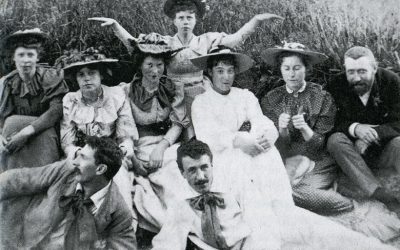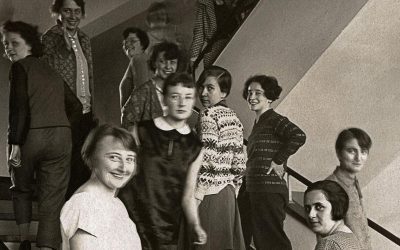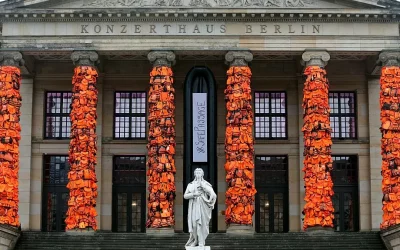In the vibrant world of art, collaboration is more than just a buzzword—it’s a powerful catalyst for growth and innovation. For women artists seeking to expand their horizons and boost their careers, cross-disciplinary projects offer a unique pathway to success. These collaborations break down traditional barriers, allowing artists to explore new techniques, perspectives, and markets.
Imagine a ceramic artist partnering with a tech expert to create interactive sculptures, or a painter collaborating with a scientist to visualise complex data through art. These exciting possibilities not only push creative boundaries but also open doors to new opportunities and audiences. In this post, we’ll explore how embracing collaborative, cross-disciplinary projects can supercharge your artistic career, providing you with fresh inspiration, valuable skills, and a broader professional network.
Whether you’re an emerging artist looking to make your mark or an established creator seeking new challenges, the power of collaboration can take your career to new heights. Let’s dive into the world of cross-disciplinary art projects and discover how they can transform your artistic journey.
Why Collaboration Matters for Women Artists
Collaboration is a game-changer for women artists. It’s like having a super-powered support system that helps you grow and shine. When women artists team up, they create a strong community where they can share ideas and cheer each other on. This is super important because the art world hasn’t always been fair to women. By working together, women artists can overcome obstacles and fight unfair treatment.
One of the coolest things about collaboration is how it boosts visibility for women in art. When female artists join forces, they create a bigger splash in the art world. This is especially great for artists who don’t usually get much attention. Working together also opens doors to new opportunities. You get to meet more gallery owners, join exciting art events, and connect with important people in the industry. Plus, when the creative journey gets tough, having artist friends who understand can really help you keep going. By supporting each other, women artists aren’t just making great art – they’re also helping to make the art world a fairer place for everyone.
Breaking Boundaries: Exploring Cross-Media Partnerships
Cross-media partnerships are changing the game for artists. These collaborations mix different types of media like film, TV, books, and games. It’s like creating a big, interconnected world for your art. When artists work across different media, they can tell bigger stories and reach more people. It’s a chance to try new things and push your creativity to new levels.
These partnerships are great for artists who want to grow. You get to work with different tools and styles, which can spark new ideas. It’s also a way to meet new people in the art world and maybe even team up for big projects. Working across media can help you show your art to more people and maybe even find new fans. Plus, it’s a smart way to promote your work and build your brand. By mixing different types of media, you can create art experiences that are more exciting and engaging for your audience.
The Science of Art: Bridging Art and Scientific Disciplines
Art and science might seem like total opposites, but they’re actually more alike than you think. Both help us understand the world, just in different ways. Science uses experiments and facts, while art uses feelings and creativity. When artists and scientists work together, amazing things can happen. They can make complex ideas easier to understand and create new ways of looking at things.
These art and science team-ups are becoming more popular. They lead to new discoveries and fresh ideas in both fields. Throughout history, some of the biggest breakthroughs happened when art and science mixed. Think of Leonardo da Vinci – he was both an artist and a scientist! Today, many schools and researchers are combining art and science in their work. This helps engage more people with scientific ideas by making them more relatable and interesting. While art and science have different methods, they can work together to inspire new thoughts and create exciting projects.
Moving Forward: Tech Meets Creativity: Art and Technology Collaborations
Art and technology are teaming up in exciting ways, creating new forms of art that were once just dreams. Imagine sculptures that move and respond to you, or art you can step into using virtual reality goggles. These are real things happening right now! Artists are working with robots, computers, and even artificial intelligence to make art that’s interactive and mind-blowing.
Some artists are making installations that change based on how you move or what you do. Others are using technology to create art you can wear. There’s even art that uses holograms to make images that look like they’re floating in the air! This mix of art and tech is also changing how we learn about art. It’s making it easier and cheaper to create and share art. As we move forward, these collaborations between art and technology are opening up new ways for people to experience and enjoy art. It’s an exciting time for artists and art lovers alike!
Global Perspectives: Cross-Cultural Art Projects
Cross-cultural art projects serve as powerful tools for bridging cultural divides and fostering global understanding. They allow artists to transcend geographical boundaries and cultural differences, creating a shared visual language that speaks to universal human experiences[1][4].
2. Challenging Stereotypes:
These projects often challenge stereotypes and dismantle prejudices by providing nuanced portrayals of different cultures. This helps in fostering a more inclusive and empathetic global society[1].
3. Globalization’s Impact:
Globalisation has led to increased cultural exchange, influencing the aesthetics, themes, and materials used in public art and urban design worldwide. This trend reflects the interconnectedness of our world[4].
4. Technology’s Role:
Advancements in technology have made cross-border collaborations easier, fostering understanding and creativity among artists from different cultures[4].
5. Balancing Global and Local:
There’s a challenge in balancing global influences with preserving unique cultural characteristics in public spaces. The goal is to create art that is globally relevant while still maintaining local identity[4].
6. Social Cohesion and Community Development:
Participation and collaboration in cross-cultural art projects can promote social cohesion and community development by fostering understanding and empathy across cultures[6].
7. Educational Value:
Incorporating global perspectives in art education develops cultural knowledge, communication skills, and the ability to collaborate across cultural boundaries. It fosters empathy and promotes critical thinking[7].
8. Artist Collaborations:
There are numerous examples of successful cross-cultural artist collaborations throughout history, such as Andy Warhol and Jean-Michel Basquiat, which have produced innovative and influential works[5].
9. Fashion and Art Collaborations:
Cross-cultural perspectives are also evident in collaborations between artists and fashion brands, bringing diverse artistic visions to a global audience[10].
10. Challenges:
While enriching, cross-cultural art projects can be complex. They require acceptance of otherness, openness to new cultures, and readiness for trial and error. Balancing the need for in-person collaboration with environmental and budget concerns is also a challenge[11].
These cross-cultural art projects and perspectives play a crucial role in today’s globalised world, fostering understanding, challenging preconceptions, and creating innovative artistic expressions that reflect our interconnected global community.
Empowering Through Collectives: Feminist Art Initiatives
Feminist art collectives are powerful forces in the art world, bringing women artists together to create change. These groups have been challenging gender inequality in art since the 1970s, and they’re still going strong today. They cover all kinds of art, from paintings to performances and even digital media. The main goal? To get more women artists into galleries and museums.
These collectives do more than just make art. They teach people about women’s contributions to art history and today’s art scene. Many of them also look at how gender connects with race, class, and sexuality. They’re great for networking too – women artists can meet, share ideas, and even mentor each other. Some collectives even create their own exhibition spaces to showcase women’s art. With social media, these groups can now reach people all over the world. They’re breaking stereotypes and showing that women’s art is diverse and powerful.
Funding Your Vision: Collaborative Approaches to Art Financing
Getting money for art projects can be tough, but working together can make it easier. There are lots of ways artists team up to fund their work. One popular method is crowdfunding, where lots of people give small amounts of money. Platforms like Kickstarter and Patreon are great for this. Some artists from groups to share costs for big projects or exhibition spaces.
Grants and residencies are another way to get funding, and artists often work together on applications. Some artists partner with businesses, making art for them in exchange for funding. Communities sometimes chip in to fund public art projects. Artists also team up with each other or with art institutions to share costs and resources. Online platforms let artists sell directly to buyers, helping fund future projects. Working together on exhibitions can help split costs and profits. Non-profit organisations and even some governments offer funding for collaborative art projects. All these team efforts show that when artists work together, they can make their visions come to life.
Career Boost: How Collaboration Expands Your Skillset
Working with others is like a superpower for your career. When you collaborate, you get to see how other people think and work. This opens your mind to new ideas and ways of doing things. You might learn new techniques or how to use tools you’ve never tried before. Plus, working in a team helps you get better at talking to people and being a leader.
Collaboration is great for solving problems too. When you work with others, you can come up with better solutions by combining everyone’s ideas. It’s also a great way to meet new people in your field, which can lead to exciting job opportunities. Working on different projects with different people helps you become more flexible in your work. You get to become an expert in your area while also learning about other fields. Getting feedback from your teammates helps you grow and get better at what you do. And when you mix different ideas and skills together, you often end up creating something new and exciting that you couldn’t have done alone.
Conclusion:
As we wrap up our journey through the world of collaborative art, remember that teamwork can truly make your artistic dreams come true. Whether you’re teaming up with tech experts, scientists, or artists from different cultures, each collaboration opens up new doors for your creativity and career. Don’t be afraid to step out of your comfort zone and try something new. Your next big breakthrough might be just one collaboration away!
If you’re excited to start your collaborative art journey but need more guidance, feel free to reach out. I’m here to help you navigate these exciting opportunities. Drop me an email at semra@semrajelil.com, and let’s explore how collaboration can boost your artistic career together.
FAQs:
1. Q: What is cross-media collaboration in art?
A: It’s when artists work with different types of media, like combining painting with digital art or sculpture with video.
2. Q: How can technology help in creating art?
A: Technology can help make interactive art, virtual reality experiences, or even use AI to create new artworks.
3. Q: What are some benefits of collaborating with scientists as an artist?
A: You can gain new perspectives, visualise scientific concepts, and create art that explains complex ideas in simple ways.
4. Q: How do cross-cultural art projects help artists?
A: They help artists learn about different cultures, challenge stereotypes, and create art that speaks to people worldwide.
5. Q: What are feminist art collectives?
A: They’re groups of women artists who work together to support each other and promote women’s art in galleries and museums.
6. Q: How can I fund my collaborative art project?
A: You can try crowdfunding, apply for grants, seek sponsorships, or team up with other artists to share costs.
7. Q: What skills can I gain through artistic collaboration?
A: You can improve your communication, problem-solving, and teamwork skills, as well as learn new artistic techniques.
8. Q: Are there any challenges in cross-cultural art collaborations?
A: Yes, like language barriers or different cultural norms, but these challenges often lead to unique and exciting art.
9. Q: How has globalisation affected art?
A: It’s made it easier for artists to work together across borders and share ideas from different cultures.
10. Q: Can collaboration help me get my art into galleries?
A: Yes, collaborating can help you create more innovative work and expand your network, which can lead to more exhibition opportunities.




0 Comments